Risk Factors, Crisis and Communication: Scenario and Literature Review
VerifiedAdded on 2021/04/21
|6
|1181
|81
Report
AI Summary
This report, titled "Assessment 2: Risk Factors, Crisis and Communication," examines the increasing threat of terrorism caused by crime mafias in the United States. It outlines the scenario's impact, including loss of life and property damage, and proposes communication strategies to alert the public and address the crisis. The literature review draws on research by Heath (2006), Veil, Buehner, & Palenchar (2011), Sandman (2006), and Heide & Simonsson (2014) to explore best practices in crisis communication. Key themes include pre-, during-, and post-crisis communication, the importance of clear and timely messages, and the use of social media. The report discusses various communication approaches based on public concern levels and emphasizes the need for internal crisis management and stakeholder engagement. It concludes by highlighting the importance of proactive and effective communication to mitigate the negative consequences of crises.
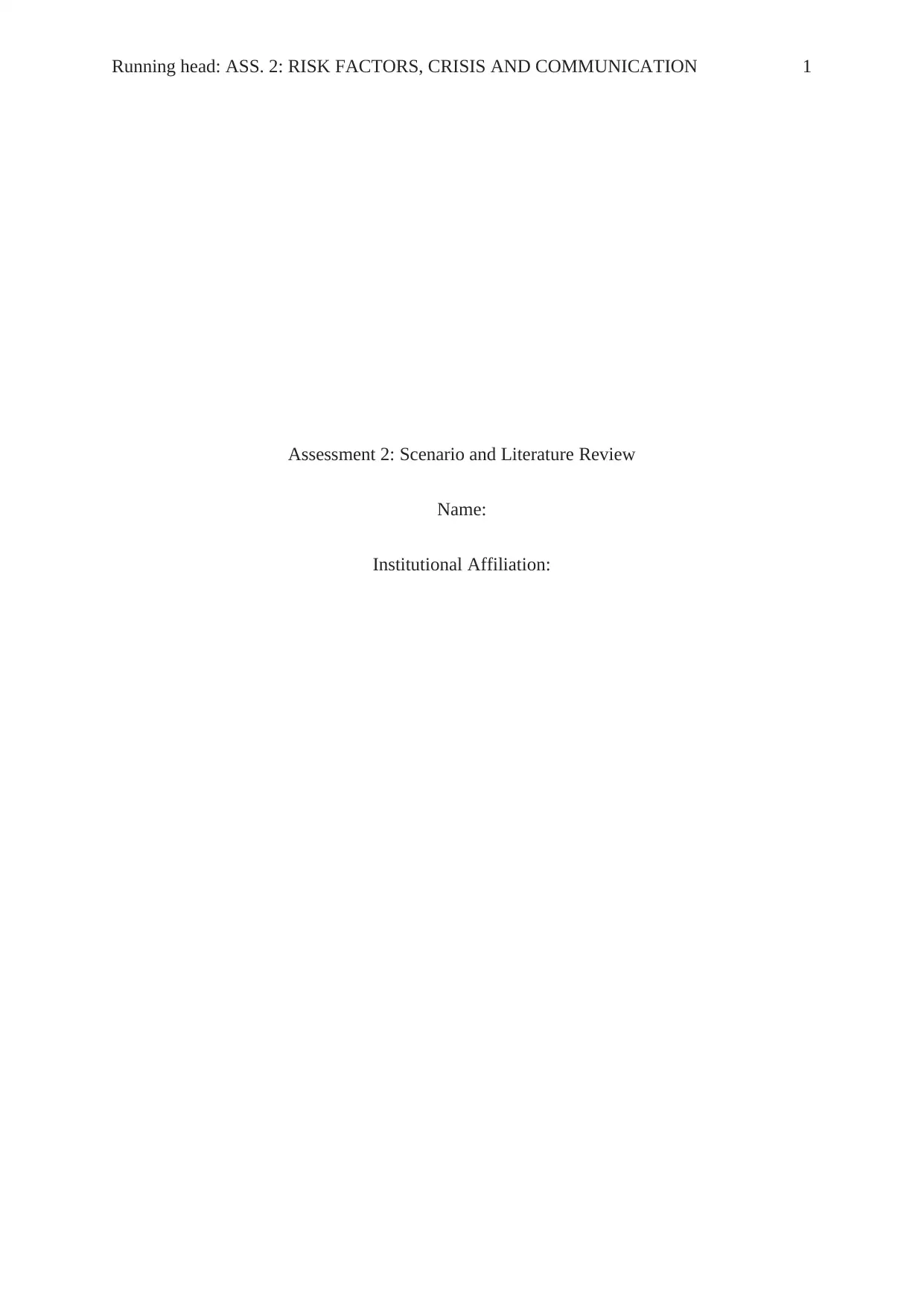
Running head: ASS. 2: RISK FACTORS, CRISIS AND COMMUNICATION 1
Assessment 2: Scenario and Literature Review
Name:
Institutional Affiliation:
Assessment 2: Scenario and Literature Review
Name:
Institutional Affiliation:
Paraphrase This Document
Need a fresh take? Get an instant paraphrase of this document with our AI Paraphraser
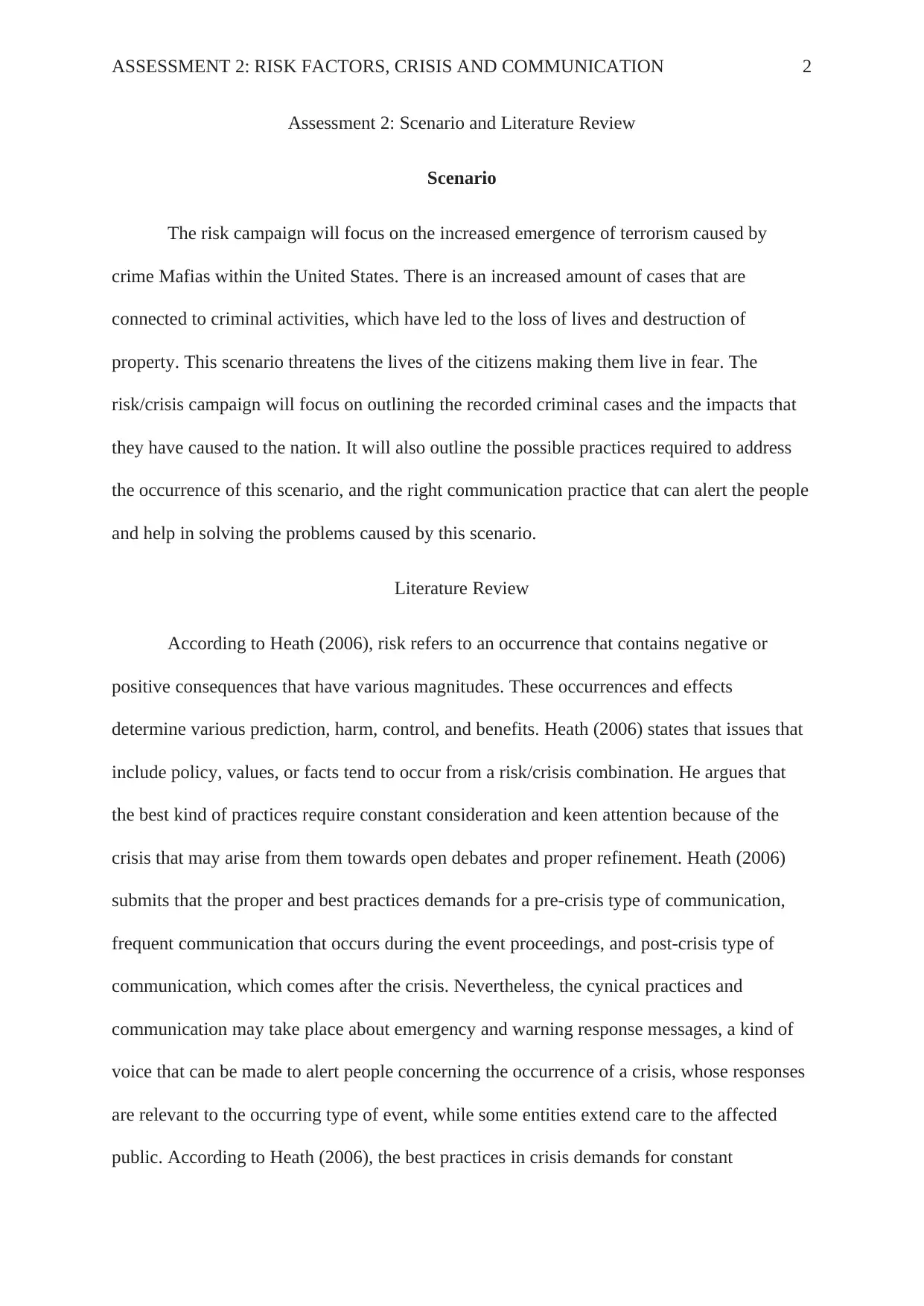
ASSESSMENT 2: RISK FACTORS, CRISIS AND COMMUNICATION 2
Assessment 2: Scenario and Literature Review
Scenario
The risk campaign will focus on the increased emergence of terrorism caused by
crime Mafias within the United States. There is an increased amount of cases that are
connected to criminal activities, which have led to the loss of lives and destruction of
property. This scenario threatens the lives of the citizens making them live in fear. The
risk/crisis campaign will focus on outlining the recorded criminal cases and the impacts that
they have caused to the nation. It will also outline the possible practices required to address
the occurrence of this scenario, and the right communication practice that can alert the people
and help in solving the problems caused by this scenario.
Literature Review
According to Heath (2006), risk refers to an occurrence that contains negative or
positive consequences that have various magnitudes. These occurrences and effects
determine various prediction, harm, control, and benefits. Heath (2006) states that issues that
include policy, values, or facts tend to occur from a risk/crisis combination. He argues that
the best kind of practices require constant consideration and keen attention because of the
crisis that may arise from them towards open debates and proper refinement. Heath (2006)
submits that the proper and best practices demands for a pre-crisis type of communication,
frequent communication that occurs during the event proceedings, and post-crisis type of
communication, which comes after the crisis. Nevertheless, the cynical practices and
communication may take place about emergency and warning response messages, a kind of
voice that can be made to alert people concerning the occurrence of a crisis, whose responses
are relevant to the occurring type of event, while some entities extend care to the affected
public. According to Heath (2006), the best practices in crisis demands for constant
Assessment 2: Scenario and Literature Review
Scenario
The risk campaign will focus on the increased emergence of terrorism caused by
crime Mafias within the United States. There is an increased amount of cases that are
connected to criminal activities, which have led to the loss of lives and destruction of
property. This scenario threatens the lives of the citizens making them live in fear. The
risk/crisis campaign will focus on outlining the recorded criminal cases and the impacts that
they have caused to the nation. It will also outline the possible practices required to address
the occurrence of this scenario, and the right communication practice that can alert the people
and help in solving the problems caused by this scenario.
Literature Review
According to Heath (2006), risk refers to an occurrence that contains negative or
positive consequences that have various magnitudes. These occurrences and effects
determine various prediction, harm, control, and benefits. Heath (2006) states that issues that
include policy, values, or facts tend to occur from a risk/crisis combination. He argues that
the best kind of practices require constant consideration and keen attention because of the
crisis that may arise from them towards open debates and proper refinement. Heath (2006)
submits that the proper and best practices demands for a pre-crisis type of communication,
frequent communication that occurs during the event proceedings, and post-crisis type of
communication, which comes after the crisis. Nevertheless, the cynical practices and
communication may take place about emergency and warning response messages, a kind of
voice that can be made to alert people concerning the occurrence of a crisis, whose responses
are relevant to the occurring type of event, while some entities extend care to the affected
public. According to Heath (2006), the best practices in crisis demands for constant
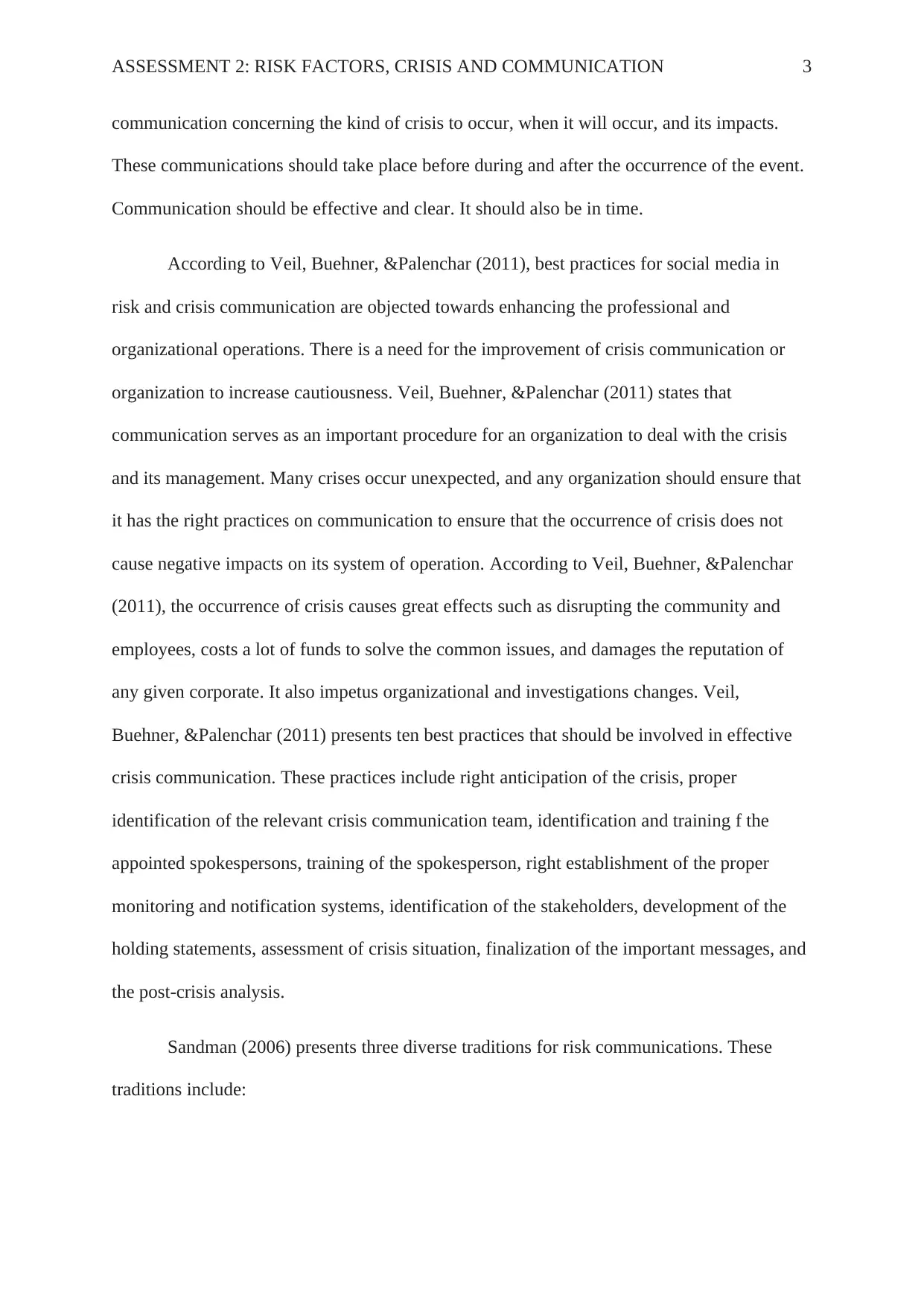
ASSESSMENT 2: RISK FACTORS, CRISIS AND COMMUNICATION 3
communication concerning the kind of crisis to occur, when it will occur, and its impacts.
These communications should take place before during and after the occurrence of the event.
Communication should be effective and clear. It should also be in time.
According to Veil, Buehner, &Palenchar (2011), best practices for social media in
risk and crisis communication are objected towards enhancing the professional and
organizational operations. There is a need for the improvement of crisis communication or
organization to increase cautiousness. Veil, Buehner, &Palenchar (2011) states that
communication serves as an important procedure for an organization to deal with the crisis
and its management. Many crises occur unexpected, and any organization should ensure that
it has the right practices on communication to ensure that the occurrence of crisis does not
cause negative impacts on its system of operation. According to Veil, Buehner, &Palenchar
(2011), the occurrence of crisis causes great effects such as disrupting the community and
employees, costs a lot of funds to solve the common issues, and damages the reputation of
any given corporate. It also impetus organizational and investigations changes. Veil,
Buehner, &Palenchar (2011) presents ten best practices that should be involved in effective
crisis communication. These practices include right anticipation of the crisis, proper
identification of the relevant crisis communication team, identification and training f the
appointed spokespersons, training of the spokesperson, right establishment of the proper
monitoring and notification systems, identification of the stakeholders, development of the
holding statements, assessment of crisis situation, finalization of the important messages, and
the post-crisis analysis.
Sandman (2006) presents three diverse traditions for risk communications. These
traditions include:
communication concerning the kind of crisis to occur, when it will occur, and its impacts.
These communications should take place before during and after the occurrence of the event.
Communication should be effective and clear. It should also be in time.
According to Veil, Buehner, &Palenchar (2011), best practices for social media in
risk and crisis communication are objected towards enhancing the professional and
organizational operations. There is a need for the improvement of crisis communication or
organization to increase cautiousness. Veil, Buehner, &Palenchar (2011) states that
communication serves as an important procedure for an organization to deal with the crisis
and its management. Many crises occur unexpected, and any organization should ensure that
it has the right practices on communication to ensure that the occurrence of crisis does not
cause negative impacts on its system of operation. According to Veil, Buehner, &Palenchar
(2011), the occurrence of crisis causes great effects such as disrupting the community and
employees, costs a lot of funds to solve the common issues, and damages the reputation of
any given corporate. It also impetus organizational and investigations changes. Veil,
Buehner, &Palenchar (2011) presents ten best practices that should be involved in effective
crisis communication. These practices include right anticipation of the crisis, proper
identification of the relevant crisis communication team, identification and training f the
appointed spokespersons, training of the spokesperson, right establishment of the proper
monitoring and notification systems, identification of the stakeholders, development of the
holding statements, assessment of crisis situation, finalization of the important messages, and
the post-crisis analysis.
Sandman (2006) presents three diverse traditions for risk communications. These
traditions include:
⊘ This is a preview!⊘
Do you want full access?
Subscribe today to unlock all pages.

Trusted by 1+ million students worldwide
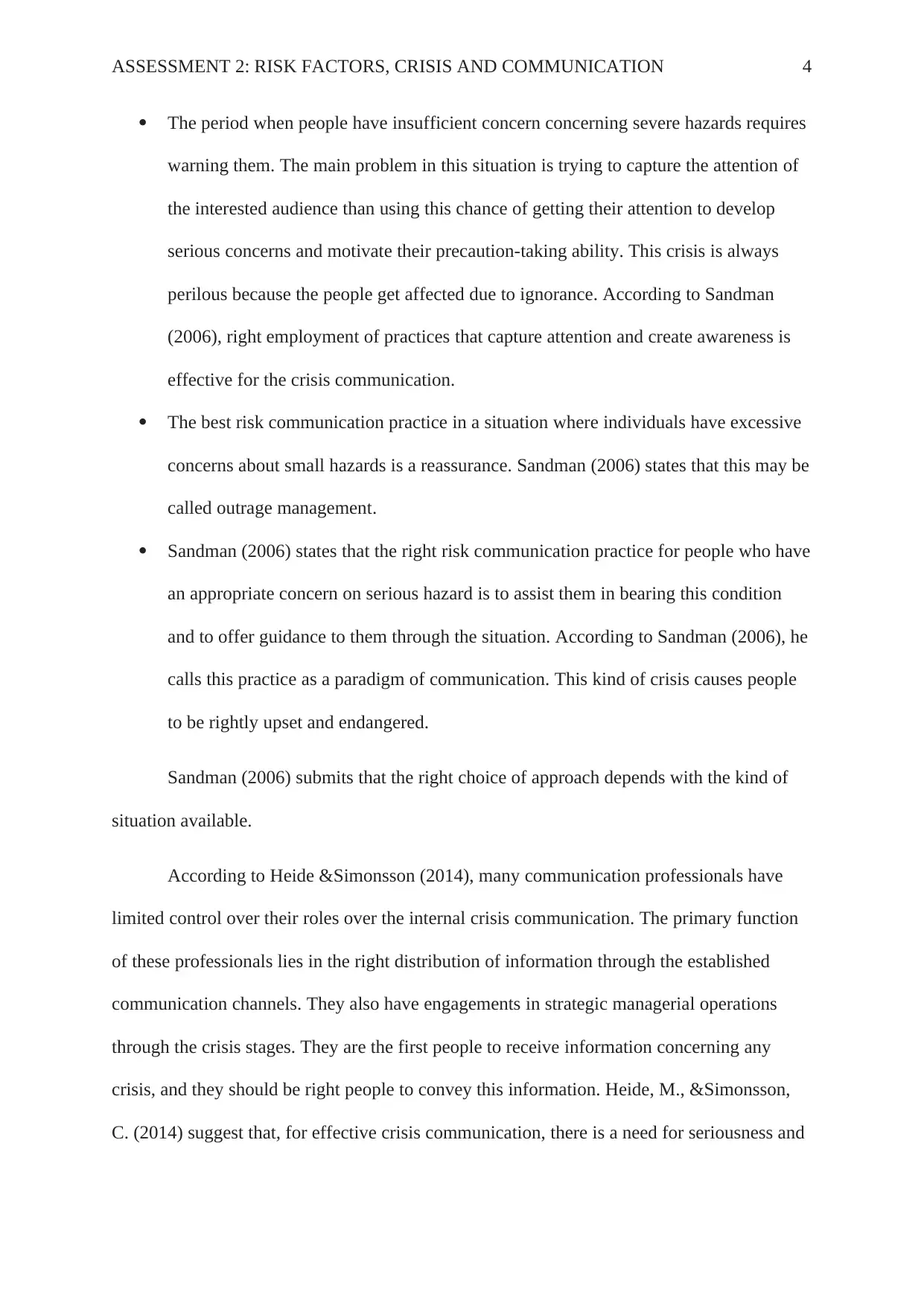
ASSESSMENT 2: RISK FACTORS, CRISIS AND COMMUNICATION 4
The period when people have insufficient concern concerning severe hazards requires
warning them. The main problem in this situation is trying to capture the attention of
the interested audience than using this chance of getting their attention to develop
serious concerns and motivate their precaution-taking ability. This crisis is always
perilous because the people get affected due to ignorance. According to Sandman
(2006), right employment of practices that capture attention and create awareness is
effective for the crisis communication.
The best risk communication practice in a situation where individuals have excessive
concerns about small hazards is a reassurance. Sandman (2006) states that this may be
called outrage management.
Sandman (2006) states that the right risk communication practice for people who have
an appropriate concern on serious hazard is to assist them in bearing this condition
and to offer guidance to them through the situation. According to Sandman (2006), he
calls this practice as a paradigm of communication. This kind of crisis causes people
to be rightly upset and endangered.
Sandman (2006) submits that the right choice of approach depends with the kind of
situation available.
According to Heide &Simonsson (2014), many communication professionals have
limited control over their roles over the internal crisis communication. The primary function
of these professionals lies in the right distribution of information through the established
communication channels. They also have engagements in strategic managerial operations
through the crisis stages. They are the first people to receive information concerning any
crisis, and they should be right people to convey this information. Heide, M., &Simonsson,
C. (2014) suggest that, for effective crisis communication, there is a need for seriousness and
The period when people have insufficient concern concerning severe hazards requires
warning them. The main problem in this situation is trying to capture the attention of
the interested audience than using this chance of getting their attention to develop
serious concerns and motivate their precaution-taking ability. This crisis is always
perilous because the people get affected due to ignorance. According to Sandman
(2006), right employment of practices that capture attention and create awareness is
effective for the crisis communication.
The best risk communication practice in a situation where individuals have excessive
concerns about small hazards is a reassurance. Sandman (2006) states that this may be
called outrage management.
Sandman (2006) states that the right risk communication practice for people who have
an appropriate concern on serious hazard is to assist them in bearing this condition
and to offer guidance to them through the situation. According to Sandman (2006), he
calls this practice as a paradigm of communication. This kind of crisis causes people
to be rightly upset and endangered.
Sandman (2006) submits that the right choice of approach depends with the kind of
situation available.
According to Heide &Simonsson (2014), many communication professionals have
limited control over their roles over the internal crisis communication. The primary function
of these professionals lies in the right distribution of information through the established
communication channels. They also have engagements in strategic managerial operations
through the crisis stages. They are the first people to receive information concerning any
crisis, and they should be right people to convey this information. Heide, M., &Simonsson,
C. (2014) suggest that, for effective crisis communication, there is a need for seriousness and
Paraphrase This Document
Need a fresh take? Get an instant paraphrase of this document with our AI Paraphraser
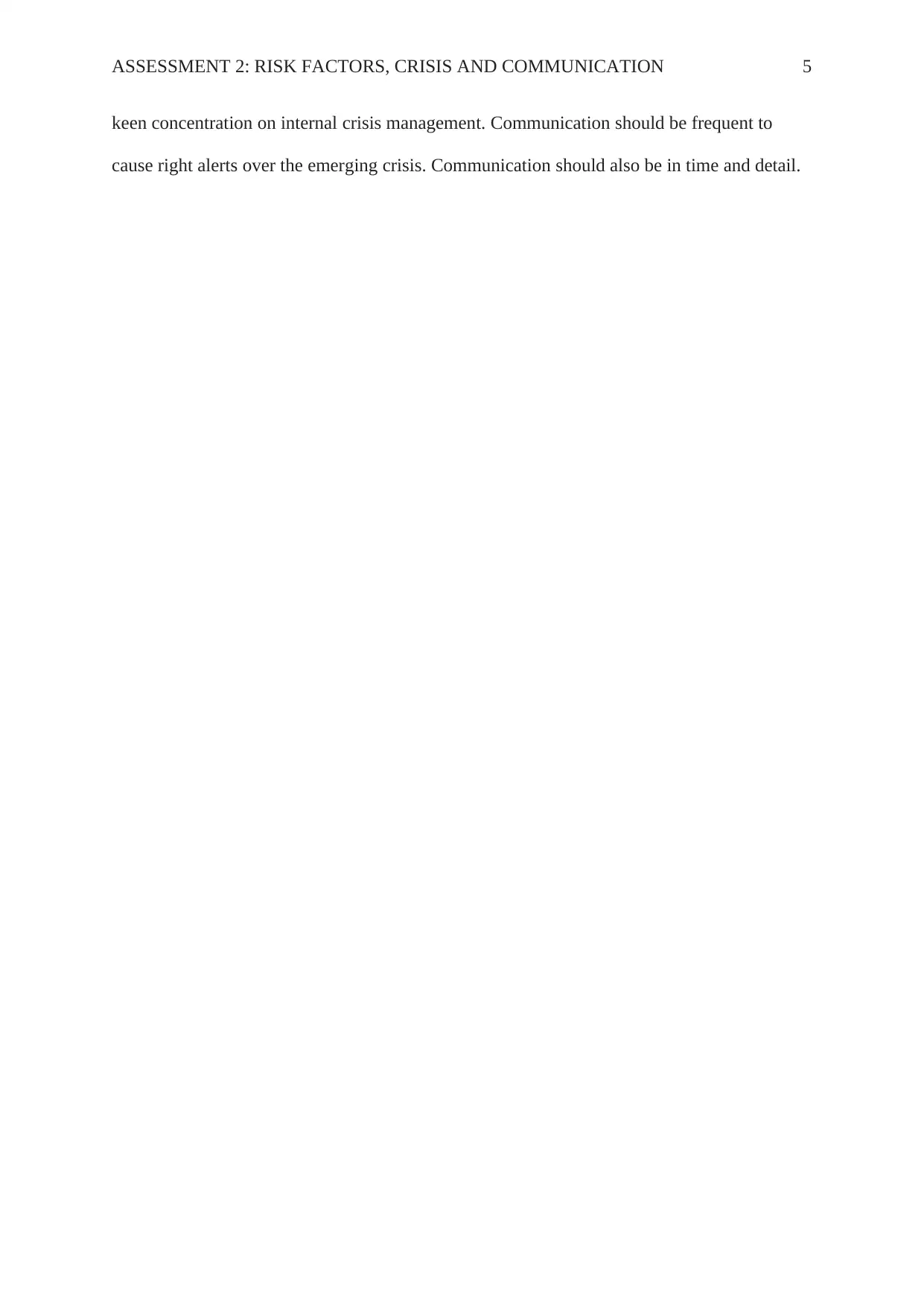
ASSESSMENT 2: RISK FACTORS, CRISIS AND COMMUNICATION 5
keen concentration on internal crisis management. Communication should be frequent to
cause right alerts over the emerging crisis. Communication should also be in time and detail.
keen concentration on internal crisis management. Communication should be frequent to
cause right alerts over the emerging crisis. Communication should also be in time and detail.
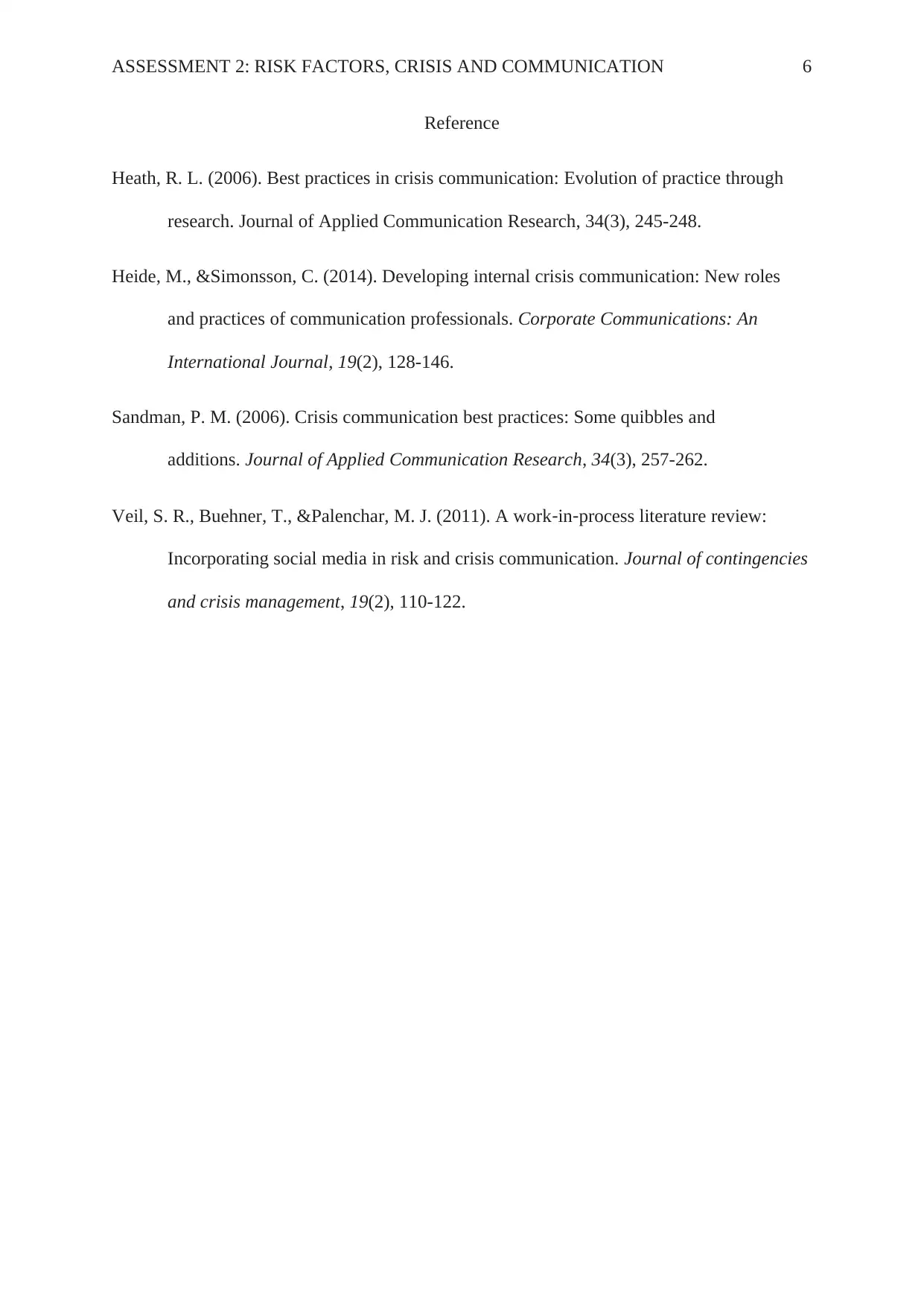
ASSESSMENT 2: RISK FACTORS, CRISIS AND COMMUNICATION 6
Reference
Heath, R. L. (2006). Best practices in crisis communication: Evolution of practice through
research. Journal of Applied Communication Research, 34(3), 245-248.
Heide, M., &Simonsson, C. (2014). Developing internal crisis communication: New roles
and practices of communication professionals. Corporate Communications: An
International Journal, 19(2), 128-146.
Sandman, P. M. (2006). Crisis communication best practices: Some quibbles and
additions. Journal of Applied Communication Research, 34(3), 257-262.
Veil, S. R., Buehner, T., &Palenchar, M. J. (2011). A work‐in‐process literature review:
Incorporating social media in risk and crisis communication. Journal of contingencies
and crisis management, 19(2), 110-122.
Reference
Heath, R. L. (2006). Best practices in crisis communication: Evolution of practice through
research. Journal of Applied Communication Research, 34(3), 245-248.
Heide, M., &Simonsson, C. (2014). Developing internal crisis communication: New roles
and practices of communication professionals. Corporate Communications: An
International Journal, 19(2), 128-146.
Sandman, P. M. (2006). Crisis communication best practices: Some quibbles and
additions. Journal of Applied Communication Research, 34(3), 257-262.
Veil, S. R., Buehner, T., &Palenchar, M. J. (2011). A work‐in‐process literature review:
Incorporating social media in risk and crisis communication. Journal of contingencies
and crisis management, 19(2), 110-122.
⊘ This is a preview!⊘
Do you want full access?
Subscribe today to unlock all pages.

Trusted by 1+ million students worldwide
1 out of 6
Your All-in-One AI-Powered Toolkit for Academic Success.
+13062052269
info@desklib.com
Available 24*7 on WhatsApp / Email
![[object Object]](/_next/static/media/star-bottom.7253800d.svg)
Unlock your academic potential
Copyright © 2020–2025 A2Z Services. All Rights Reserved. Developed and managed by ZUCOL.